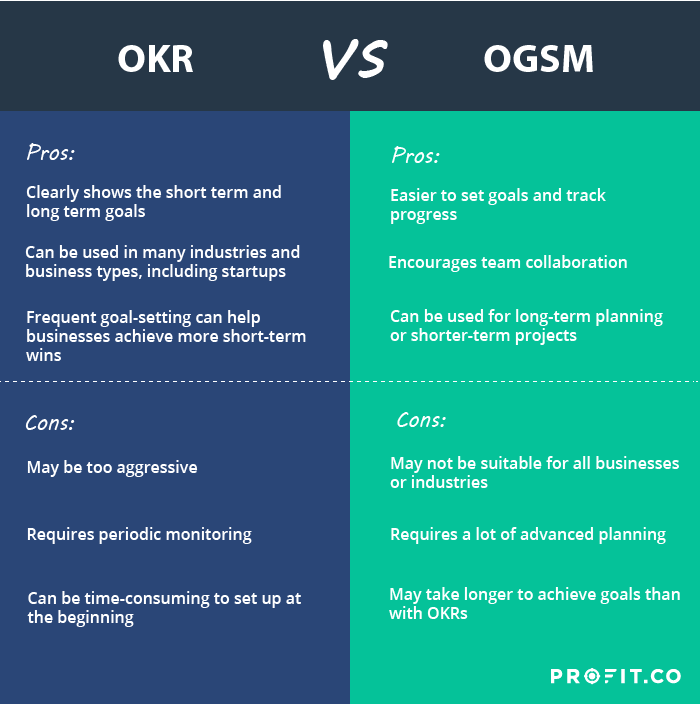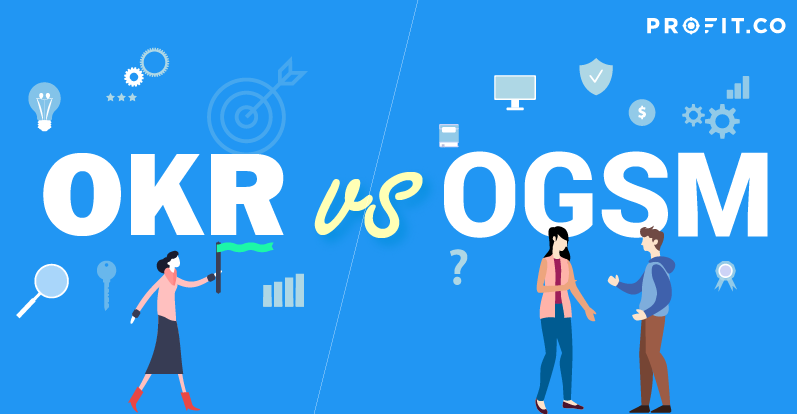Objectives can be compared to a compass bearing by which a ship navigates… Without a compass bearing, a ship would neither find its port nor be able to estimate the time required to get there.
What’s the Main Difference Between OGSM and OKRs?
OGSM is a strategic planning approach that can be used to develop long-term plans for businesses of all sizes. The method works best when applied from the top-down, with corporate or business leveling strategies and policies being communicated down through individual divisions until they reach team members who will carry out their instructions in your desired outcome. This creates goal alignment across every level within the company. OKRs are a great tool to help break down long-term strategy into short-term goals. While goals can cascade down an organization, they can also be created bottom-up, with the input coming from a person’s own goals or those who report directly onto them in an organizational structure. With this structure, department, team, and even company OKRs can be informed by employee-level insights and priorities. Want to manage your OKRs on an agile and intuitive software? Start your Profit.co free trial today!OGSM and OKR Examples
Now that you know the differences between OGSM and OKRs, take a look at some examples.
In order to give you a better understanding of how these strategies work, below are two examples:Example A: Company using OGSM
ABC Corporation is looking to expand its market share in Europe over the next three years.
Their overall goal is to increase their revenue by 25% and they have divided this up into objectives that will help them achieve their end goal:
- Increase market share in Europe by 15% over the next three years
- Revenue growth of 25% over the next three years
- Launch five new products in the European market over the next three years
- Sign distribution agreements with two new suppliers in Europe over the next three years
As you can see, ABC Corporation’s long-term goals are broken down into objectives. These will be achieved through key results that align to each objective and help achieve their end goal of increasing revenue by 25%.
Since OGSM focuses on a longer timeframe, key results are typically longer-term, such as an increase of 15% market share or 25% revenue growth.Example B: Company using OKRs
XYZ Inc is looking to hire and onboard five new employees over the next six months in order to meet their growing demand for product development and customer services.This company has set quarterly targets which align with their plan for hiring five new employees:
- Hire an additional developer and QA tester by the end of first quarter
- Increase customer support team by two members who can be fully trained on product knowledge, sales training etc. by the end of the second quarter
- Further, increase development team by one more member within third quarter to meet the increasing demands of product development
- Increase sales and marketing team by one member within the fourth quarter
As you can see, XYZ Inc’s quarterly targets are shorter-term than ABC Corporation’s objectives. This is because they have a shorter timeframe to achieve their goal of hiring five new employees.
Since OKRs typically describe goals and key results to be completed within a quarter, they work best for this company. At the end of each quarter, XYZ Inc will assess whether their key results have been achieved or not and adjust accordingly if required. This way, they can ensure they are always on track to achieve their goal.How Often Are OGSM and OKRs Set?
One key difference between OGSM and OKRs is how often they are set. OGSM usually involves setting goals quarterly or annually, while OKRs can be set more frequently, such as monthly or even weekly.What Are the Advantages and Disadvantages of Using OGSM and OKRs?

Advantages of OGSM
- Easier to set goals and track progress
- Encourages team collaboration
- Can be used for long-term planning or shorter-term projects
Disadvantages of OGSM
- May not be suitable for all businesses or industries
- Requires a lot of upfront planning and work
- May take longer to achieve goals than with OKRs
Advantages of OKRs
- Easy for employees to understand what’s expected in the short term and long term
- Can be used with a variety of different types of businesses or industries, including startups
- Frequent goal setting can help businesses achieve more short-term wins
Disadvantages of OKRs
- May be too aggressive or unrealistic for some businesses
- Requires a lot of monitoring and tracking to ensure goals are being met
- Can be time-consuming to set up at the beginning
OKRs can be more frequently updated, which allows for more agile goal setting. However, this also requires more time and effort on the part of managers to keep track of progress.
OGSM may be easier to manage than OKRs because it involves setting goals less frequently. However, this can lead to stagnation if goals are not revisited often enough.



